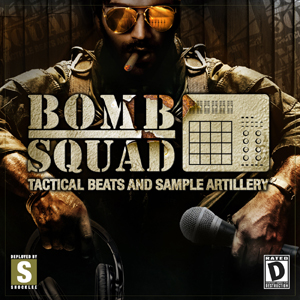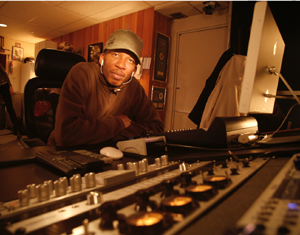Hank Shocklee: Inside the Making of BOMB SQUAD Tactical Beats and Sample Artillery
FREEPORT, LONG ISLAND: If inspiration is ever in short supply, producers and artists have two excellent options available:
1) Listen to music generated by Hank Shocklee
2) Drop his smashing new sample pack into the project
As a co-founder of Public Enemy and the seriously productive production outfit the Bomb Squad, Shocklee has long stood as one of NYC’s most vital musical resources. A sampling pioneer who reshaped the landscape with his part in landmark albums like It Takes a Nation of Millions to Hold Us Back and Fear of a Black Planet, Shocklee has just lit up another explosive for us all to enjoy: the BOMB SQUAD Tactical Beats and Sample Artillery sample pack.
Available as of last week from Loopmasters, BOMB SQUAD has 800 MB+ of royalty-free audio loops, beat, basses, and noisy things, meaning we can now all go Shocklee-style in an instant if we want. Already an expert with his signature filtering, multi-band microloop sampling, and truncation techniques, Shocklee went into organic new territory with BOMB SQUAD. In the process, the sample master grew an entirely new head for engineering — all the better for the rest of us to blow up our next record, score, or sound design.
Why do you enjoy the art/science of sampling? What are the challenges and rewards of making a great sample?
Well, it’s like everything came full circle. I started by taking samples from records, and manipulating tiny snatches of hits and squeals, snares and kick snippets together and creating a collage if you would, almost like a painting vibration. But as the technology moved on, it took sampling and made it obsolete — taking samples from records. Because now with what you can do, you have so much more at your fingertips to control the entire process.
The main reason I made samples was it was practically impossible to mic a kit — very costly — so it was just very inexpensive to take it from a record. Now you can recreate your entire room. It can be a ’70’s, ’80’s or ‘90’s Neve board, an SSL, a Trident, and you can create the actual sound of a room with reverb and IR responses. So now the art of sampling becomes more of sound designing. It just allows you to have so much more flexibility and control over what you’re trying to create.
To that end, why is it important to you to share samples with other musicians/producers via sample packs?
Because, for me, it’s an extension of creating that community. I think one of the things that sampling has done is open up an entire palette for people to use sounds from all different genres: jazz, Afro-Cuban, reggae, or rock. It doesn’t matter where it came from.
But the backlash was also a lot of sampling lawsuits arose from that, which prohibited people from using records because of the restrictions that were placed upon using the actual recording. Creating sample packs allows you to share those sounds you create with your producer community. Everybody can benefit now from your manipulation or sound design and creation and use it in your project. These are royalty-free, so now people can feel free to create the kinds of sounds that we created in the late ’80’s or early ’90’s.
You said that you wanted BOMB SQUAD to have a natural, organic sound. Why was this an important approach to you?
Because everything is pretty much electronic these days, to me one of the challenges when you’re working with everything inside the computer is to make it sound as human and natural as possible — as natural to the human ear as you possibly can get.
Since we’re doing everything in a non-organic way, for me, its just trying to make something that sounds like it would have been created in the ‘70’s or the ‘80’s. It gives you that feeling without necessarily having to go in and re-record those sounds yourself.
Give us some insights on how you approached making the individual samples in BOMB SQUAD. What are some key tools and techniques you used?
It’s kind of like using a lot of different techniques. The main DAW that I used was Ableton Live, and I also used Reason 5.0. The creation process to me whether it be kick, snare, hat or bass line, or even sound effects, was first using the effects in very, very creative ways.
For example: taking a synth sound, running it through a guitar amp, creating a room for that guitar amp, then creating a simulated microphone for that amp as well. As you’re taking those sounds, then you’re manipulating the sound of the reverb and all those effects as well.
So you’re kind of sampling, time-stretching…it’s hard to say what particular technique because I use so many techniques in creating them. A lot of it is just knowing how to put the effects in the chain, then understanding how to sample and then resample. And then of course, you have to understand the tonal aspect, or EQ. I have an incredible amount of different EQs, delays and compressors. Each delay is different, and I use a tremendous amount of distortion and saturators in order to create the sound.
Because the sound I created was more of the lo-fi variety, the first thing everybody says when they listen is, “Wow, didn’t you mix them?” and I say, “Yeah,” because what they’re designed to do is be used in conjunction with your other sounds, and most of the sounds you have in your digital system are pretty clean, shiny, and sequency. This pack wanted to go for a tighter — a little more grainier — sound. If you were to equate it with film, I was going for that black and white film noir kind of vibe, but in a sonic palette.
What studio did you record BOMB SQUAD in?
I did this out of my studio on Long Island, in Freeport. Pretty much everything was all plugins. Everything was digital simulating analog, 100% in the box. I run everything through the TL Audio Fat Track, which is basically a two-track summing of the bigger TL Audio board. I ran it through the Fat Track just for some warming up and tube summing, but nothing really expensive on that level. I wanted to create everything inside the box to show you could make inside-the-box feel and respond like it was analog tape.
Why did you want to approach it that way?
Coming from my hip hop background, everything for me was about taking electronic gear and then running it through an analog source — some type of mixing console — and then applying what was needed to tone shape or enhance it afterwards.
The difference the computer offers you is that you’re generating not just electronic sound, but also generating the mixing console and the effects. I don’t think there’s an advantage or disadvantage to using either/or, other than that it becomes more of an ease-of-use issue, and some people can hear sonic differences between the two. For me, it was the challenge of trying to take what was done on a huge console in a big room, and recreating that inside the computer.
What did you yourself learn in the process of creating BOMB SQUAD? How did it help you to progress as a producer and engineer?
First of all, it taught me the engineering part. One thing I never wanted to have to be involved with was the engineering aspect of making music or audio, because I think there’s another head necessary in the studio environment: One person solely responsible for the creative aspect, and another head solely responsible for the technical aspect.
I think that combination is still very, very necessary, but the challenge for me here was the creative head also having the technical head, and then distinguishing between the two. That to me was the biggest learning curve. It made me understand a lot about the recording process — frequency and analysis, phase isolation and cancellation. It made me think about things I never really had to think about when I was just making records solely as a producer.
In your opinion, what’s the way that end users can maximize their use of sample packs, in terms of efficiency and how it affects their creativity? Why are these good tools to have on hand?
The first thing that comes to mind is speed. If you happen to be working on a film project or a particular genre — like hop hop, alternative rock, downtempo trip hop — the first thing is you want to get into a ballpark. Sample packs automatically put you into that space. You want a drum & bass vibration, you just go right to it. From there, your creativity starts to work. It speeds up that process.
The other aspect of it is that sample packs expand the creative palette. If you were thinking about doing a minimal house beat, you can add a drum & bass element to it, and now you’re creating this hybrid genre. And you can start to experiment with different types of sounds, moves, vibrations, and put them together in combinations you wouldn’t normally have done if you’re programming from the start.
It sounds like putting BOMB SQUAD together was pretty satisfying.
It was kind of tedious. It was long. But it taught me a lot about the sounds that you use, and how those sounds are made. It’s kind of like starting with the seed of sound creation, and then you’re building this thing up into a track or song or project or album. It gives you better insight on what you’re trying to develop.
— David Weiss
(Special thanks to NYC engineer Phil Painson for helping to make this article happen!)
Please note: When you buy products through links on this page, we may earn an affiliate commission.








Jazzyswan
July 5, 2011 at 5:22 pm (14 years ago)It’s about time you did this Hank, I don’t know what took u so long…..As always, I love your work, and I’ll buy it right away, Best 2 U, Glenn Swan